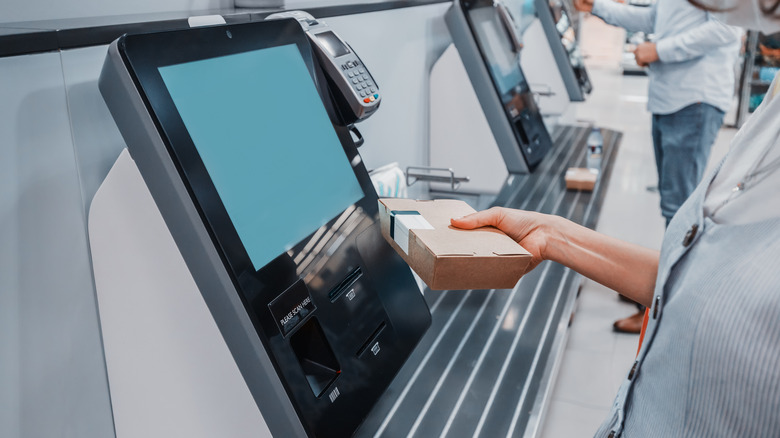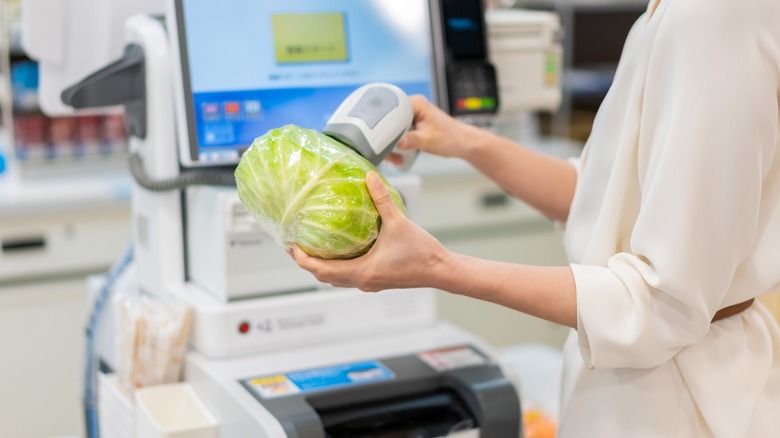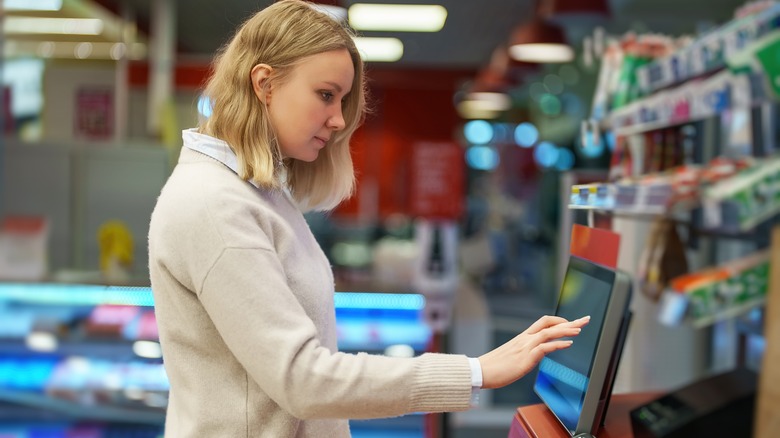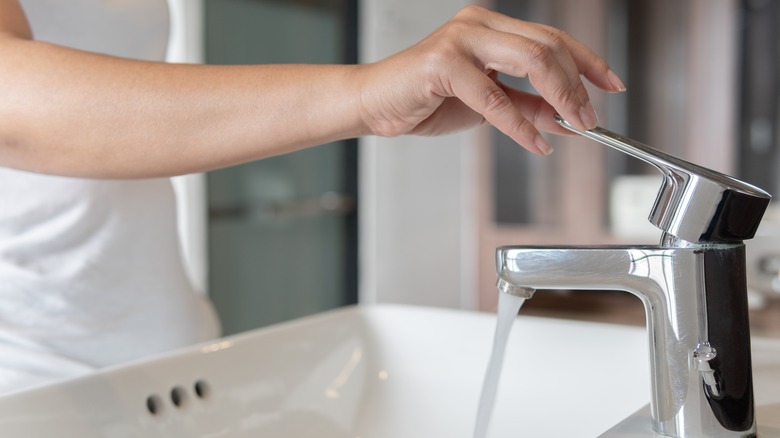Expert Explains Why You May Want To Avoid The Self-Check-Out Line When You Shop
You might not think twice about the layout of a grocery store (unless you are struggling to find those pesky spices like sumac) but grocery stores are designed with the consumer in mind. Dating as far back as 1960, researchers like Herbert Krugman have delved into the psychology of supermarket design (via Inkblot Analytics). Today, most grocery stores utilize a grid design to provide organization to the store layout, however, there are some clever tricks that you might notice the next time you enter your local market. For example, most grocery stores utilize a counter-clockwise design, meaning that you enter the store and go to the right, and exit on the left (per Regained Wellness). Stores also often place the most essential items — like milk and eggs — towards the back of the store. Of course, the simple logic behind these design features is that they'll lead to more spending, one way or another.
Other features of grocery stores are geared toward convenience, and even toward saving the cost of labor. Take the self-checkout, for example. By some estimates, as many as 38% of checkout lanes in chain grocery stores in the United States are self-checkouts, reports Grocery Dive. However, a 2021 survey found that nearly 67% of shoppers have experienced a failed checkout process at a self-checkout. It turns out that self-checkouts may be failing in more than one way. Keep reading to find out why self-checkouts might also be bad for your health.
Think twice (and wipe once) before using the self-checkout line
Please scan your next item, and don't forget to wash your hands. Health experts are now advising shoppers to wash their hands after contact with self-service checkouts, due to the rather grotesque results of a recent study (via Study Finds). Researchers from the Liverpool School of Tropical Medicine (backed by the NHS public health officials) took samples of everyday items that humans typically come into contact with and probed them for bacteria, reports the New York Post. The results from the laboratory found that self-checkout stations not only contained 5 types of disease-causing bacteria, one of them — Enterococcus — is commonly present in human feces (per Daily Mail).
When it comes to matters of the fecal type being in our environment, you might be surprised to learn that we're completely inundated. According to Health eNews, fecal matter can be found in beards, cell phones, and even your toothbrush. However, when you practice basic hygiene like washing your hands, the odds of getting sick are rather low.
How bacteria makes their home at self-checkouts
In a microscopic world so tiny that our limited perception couldn't possibly see it, bacteria live on every surface and can be found anywhere that you look. According to the Australian Academy of Science, scientists can't see these microorganisms unless they grow them to a large enough number to be visible. Bacteria lurk in the shadows and can contribute to a number of diseases like food poisoning, urinary tract infections, and strep throat (per Cleveland Clinic). Dr. Adam Roberts, a microbiology expert who completed the swab results in the groundbreaking study, explained that when someone goes to the bathroom and doesn't wash their hands, these bacteria can travel to other places and infect other people, as reported by Daily Mail. For those of us who are even remotely germophobic, this could sound like the stuff of nightmares.
As well as fecal matter, self-checkouts could contain other disease-causing bacteria. In fact, one of the highest bacterial loads was found in the self-checkout sample out of all samples taken throughout the study, said Dr. Roberts (per Independent). E.coli, in particular, was found on almost all the surfaces examined in the study, which also included escalator handrails and computer keyboards.
These results may not be all that surprising to you. After all, dozens of people touch the checkout screen at self-checkout stations every day, creating the perfect breeding ground for bacteria. Much of the bacteria found on touch screens are also very contagious, according to Healthline.
How to prevent the spreading of bacteria at self-checkouts
Practicing proper hygiene is undeniably one of the best ways to prevent the spread of bacterial infections. As reported by Healthline, bacteria is primarily spread by poor hygiene. Good hygiene is especially crucial for protecting individuals with weakened immune systems who may become infected more easily, says Matt Ashton, Director of Public Health for Liverpool (per Daily Mail). One way to prevent germs from spreading is to wash your hands properly after using the bathroom. "This is particularly important if you are visiting vulnerable relatives in hospitals and care homes," explains Ashton.
It's also a good idea to carry around hand sanitizer to use as soon as possible after using a self-checkout. This can stop bacteria from spreading, although handwashing with soap and water is always ideal, according to Healthline. The Centers for Disease Control and Prevention (CDC) reports that hand sanitizer does not kill every germ, and may not be as effective on hands that are visibly dirty or greasy.
Luckily, the CDC provides a step-by-step guide on how to wash your hands the proper way. Before you grab some soap, make sure your hands are wet with clean water that's either warm or cold. Afterward, you can lather your hands with the soap, making sure to scrub the backs of your hands, between your fingers, and underneath your fingernails for at least 20 seconds. Finally, use a clean towel or air dryer to dry your hands after rinsing.




